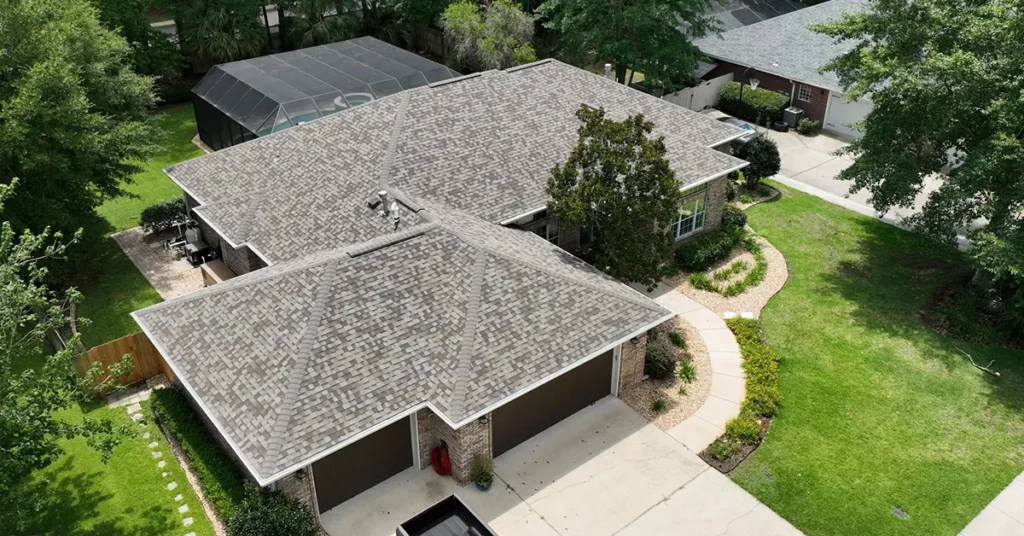Your roof does more than just keep rain out of your living room. It’s actually a complex system of different parts working together to protect your entire home. Think of it like a well-organized team where every player has a specific job to do.
When you look up at any house, you’re seeing the final result of careful planning and construction. But what you can’t see are all the important pieces hiding underneath those shingles. Understanding these roof parts can help you make better decisions about maintenance, repairs, and even buying a new home.
Let’s walk through your roof from the inside out so you’ll know exactly what keeps you dry and safe.
The Foundation: Structural Parts That Hold Everything Up
Trusses and Rafters
The most important parts of any roof are the ones you never see. At its core, a roof consists of two parts: the truss and the field. These wooden frameworks are like the skeleton of your roof structure.
Trusses are pre-built triangular frames that get delivered to your home and lifted into place by a crane. Roof trusses are highly engineered pieces of lumber connected by metal plates to form a web that supports a roof structure. They’re popular because they’re strong, affordable, and quick to install.
Rafters are individual wooden beams that builders cut and assemble on site. Trusses usually use 2x4s, while rafters are commonly made using 2x8s, 2x10s, and 2x12s. While rafters take longer to install, they give you more flexibility for custom designs and future renovations.
Both systems do the same job: they transfer the weight of your roof down to the walls of your house. Without them, your roof would collapse under its own weight, especially when you add snow or strong winds to the mix.
Roof Sheathing
Once the trusses or rafters are in place, builders cover them with roof sheathing (also called decking). Roof sheathing is also known as decking. It is the layer of material that attaches directly to your roof rafters or trusses. Sheathing serves as the base for roofing materials like shingles or metal panels.
Most homes use either plywood or OSB (oriented strand board) for sheathing. This creates a solid, flat surface to which everything else is attached. Think of it as the floor of your roof that workers can walk on during construction.
The Protection Layer: What Keeps Water Out
Underlayment
Before any shingles go on, roofers install underlayment. This is like a waterproof blanket that covers the entire sheathing. Even if a few shingles get damaged in a storm, the underlayment gives you a backup layer of protection.
Modern underlayment comes in different types. Some are made from felt paper, while others use synthetic materials that last longer and resist tears better. Either way, this layer is crucial for keeping water from getting into your home’s structure.
Shingles
Most people think of shingles when they picture a roof. They’re the overlapping pieces that create the final protective surface. Asphalt shingles are the most common choice because they balance cost, durability, and ease of installation.
But shingles aren’t just about protection. They also define how your home looks from the street. You can choose from different colors, styles, and materials to match your home’s personality.
Flashing
Flashing might be the most important roof part you’ve never heard of. These thin pieces of metal get installed wherever your roof meets something else, like a chimney, vent, or another roof section.
Water loves to find its way into these joints, but flashing creates a waterproof seal that directs water away from vulnerable spots. Without proper flashing, even a brand-new roof can develop serious leaks.
The Edges: Finishing Touches That Make a Big Difference
Eaves and Overhangs
The eaves are where your roof extends past your home’s walls. This overhang isn’t just for looks. It protects your siding from rain and helps keep water away from your foundation.
The length of your eaves matters too. Longer overhangs provide more protection but cost more to build and can look out of proportion on smaller homes.
Fascia Boards
Fascia boards are the vertical boards that run along the edge of your roof line. The vertical board around the edge of a roof serves both practical and aesthetic purposes.
These boards give your gutters something solid to attach to and hide the rough ends of your rafters or trusses. From the street, fascia boards create clean, finished lines that make your home look professionally built.
Soffits
Look up at your home’s eaves and you’ll see soffits. These are the horizontal surfaces underneath the overhang. While they might look like simple finishing pieces, soffits actually play a crucial role in ventilation.
Many soffits have small holes or vents that allow air to flow into the attic. This airflow helps prevent ice dams in winter and keeps the attic cooler in summer, which can lower energy bills.
The Water Management System
Gutters and Downspouts
Gutters collect all the water that runs off your roof and channel it to downspouts. Without this system, water would pour off your roof like a waterfall, potentially damaging your foundation, landscaping, and siding.
The size of your gutters matters. Larger roofs need bigger gutters to handle more water volume. Your local rainfall patterns also affect the size of gutters that work best for your area.
Ridge Vents
You’ll often find ridge vents at the very top of your roof, where two slopes meet. These allow hot air to escape from your attic and work together with soffit vents to create airflow.
Proper ventilation prevents moisture buildup that can lead to mold, rot, and ice dams. It’s like giving your roof a way to breathe naturally.
Special Features and Add-Ons
Dormers
Dormers are those window-like structures that stick out from sloped roofs. Dormers are essentially the structure around a window that projects from a sloped roof. This structure is set vertically on the roof slope and has its own roof.
While dormers add complexity to your roof, they also create usable space in attics and bring natural light into upper floors. They’re popular on Cape Cod and Colonial-style homes.
Skylights and Roof Windows
Some roofs include skylights or roof windows that bring natural light into interior spaces. These features require careful installation with proper flashing and weatherproofing.
While skylights can transform dark spaces, they also create potential leak points that need regular maintenance attention.
Why Understanding Roof Parts Matters
Knowing these roof components helps you in several ways. When you talk to contractors, you’ll understand what they’re explaining and can ask better questions. During home inspections, you’ll recognize potential problem areas. And when it’s time for maintenance or repairs, you’ll make more informed decisions.
Your roof is a system in which every part depends on the others. A problem with flashing can damage sheathing, and poor ventilation can affect shingles. Understanding these connections helps you maintain your roof properly and catch problems early.
FAQs
What’s the difference between trusses and rafters?
Trusses are typically 20%–50% cheaper than rafters because they require less labor and install quickly, often in a day with a crane. Rafters, on the other hand, take longer to build and require skilled carpentry. Trusses work great for standard roof designs, while rafters give you more flexibility for custom layouts and future modifications.
How long should roof shingles last?
Most asphalt shingles last 15-30 years, depending on quality, weather conditions, and maintenance. Premium shingles can last longer, while basic three-tab shingles typically need replacement sooner. Regular maintenance, like cleaning gutters and replacing damaged shingles, can extend their life.
Why is roof ventilation so important?
Proper ventilation prevents moisture buildup that can cause mold, wood rot, and ice dams. In summer, it keeps your attic cooler, which reduces air conditioning costs. In winter, it prevents warm indoor air from melting snow that then refreezes as ice dams at your gutters.
What are the most common places for roof leaks?
Most leaks happen where different roof surfaces meet, around chimneys, vents, and skylights. Flashing in these areas can deteriorate over time or get damaged by the weather. Valley areas where two roof slopes come together are also common leak spots.
How often should I inspect my roof?
You should visually check your roof at least twice a year, typically in spring and fall. Look for missing or damaged shingles, clogged gutters, and signs of wear around flashing. After major storms, do an additional inspection to check for damage.
When should I call a professional versus doing roof work myself?
Simple maintenance like cleaning gutters or replacing a few shingles might be DIY projects if you’re comfortable with heights and have the right tools. However, anything involving structural work, extensive repairs, or working with flashing should be left to professionals. Safety should always be your top priority.
Conclusion
Your roof is much more than just shingles on top of your house. It’s a carefully designed system where structural elements, protective layers, and drainage components all work together to keep your home safe and dry.
Understanding these roof parts helps you become a better homeowner. You’ll know what to look for during inspections, understand what contractors are talking about, and make smarter decisions about maintenance and repairs.
Remember that every part of your roof serves a purpose. Regular maintenance and prompt repairs keep all these components working together properly. When you take care of your roof system, it takes care of your home for decades to come.
Whether you’re buying a new home, planning a renovation, or just want to understand what’s over your head, knowing these roof basics gives you the confidence to protect one of your biggest investments.


